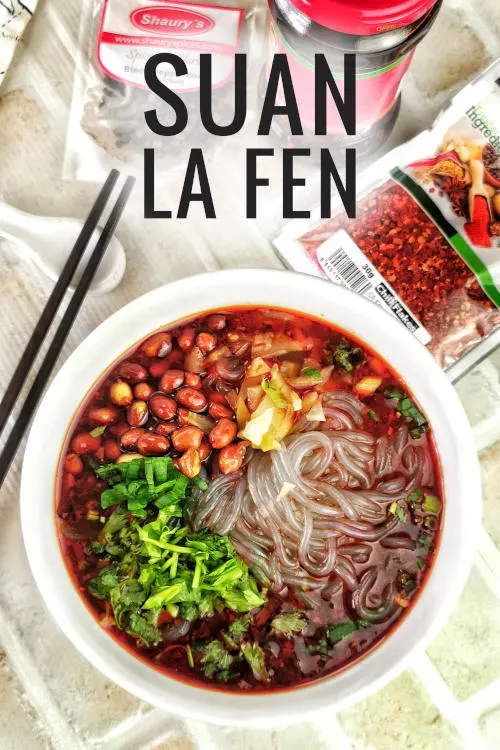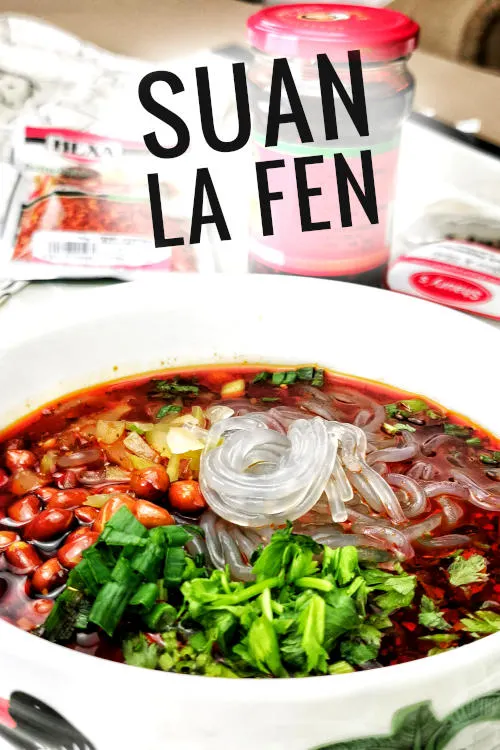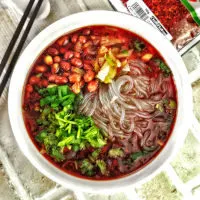Suan la fen (酸辣粉, Hot and Sour Noodles) has won over me finally, although I grew up in a Cantonese family with little exposure to other forms of cooking in the early days.
Perhaps I was born to love hot and sour stuff, and being devoid of having this spicy food since I was young makes me so addictive to the exploding flavor of Szechaun food.
So mapo tofu, hot and sour soup, dry-fried green beans, and the like have become the standard menu on my dinner rotation now,
Suan la fen is no exception. It is the direct translation from three Chinese characters 酸辣粉, which means sweet and sour noodles. It is such a popular noodle dish that there is even an instant noodles version available. However, the flavor can never match with the freshly prepared version.
This article explains how I prepare my suan la fen. Since my interpretation may differ from what is available at Szechuan of China due to the use of certain locally available ingredients, I do not claim authenticity of this recipe. The ultimate goal is to cook a bowl of noodles that satisfied my tastebuds.
Let’s get started.

Note: This post may contain affiliate links. Please read my privacy policy for more info. I may receive commissions for purchases made through links in this post. As an Amazon Associate, I earn from qualifying purchases.
How to prepare Suan La Fen 酸辣粉
I have divided the preparation into five sections.
1. Prepare the sauce with an explosive flavor
The sauce for suan la fen has a symphony of competing flavors attacking your tastebuds mercilessly, all inside one mouthful of hot and spicy noodles.
Here is the list of the components:
Vinegar. I use Chinese black vinegar (Chinkiang vinegar / 镇江香醋) to get the best flavor. I also used red vinegar 浙醋 before, and the result is equally good.
Chili oil. Although it is not difficult to make the chili oil, I prefer to get the store-fought Chinese chili oil for convenience. However, some brands such as Lao Gan Ma is now available worldwide, which you can order online easily. If you want to make it yourself, here is the link to another article on this blog to explain how to do it. The chili is made mainly with chili flakes, five-spice powder, sesame seeds, Szechuan peppercorns, fennel, cinnamon, star anise, and clove. (Ingredients may differ depending on the brands.) It is the foundation flavor of Szechuan food and is the integral part of the sauce for suan la fen.
Light soy sauce. I use an equal part of light soy sauce to vinegar to provide the savory flavor. You may adjust accordingly, but it is good to start with an equal amount. Light soy sauce is preferred to dark soy sauce because its savory flavor is more intense.
Szechuan peppercorn has a tongue-numbing effect, which is unique for Szechuan food. There are two types of Szechuan peppercorns, the red and the green, in which the green is more numbing. However, the difference is not significant in practice when combined with a myriad of other spices. There is ready-made Szechuan peppercorn powder available, although I use a spice grinder to prepare it from scratch in this recipe.
Chili flakes. I use the local chili flakes, which are not as red as the Szechuan types but still provide the same level of spiciness/hotness. I use a small number of chili flakes, but you can increase if you take the heat.
Others. You also required some sugar to balance the acidity of the vinegar. Besides that, you also need some scallion, salt, and minced garlic.
How to prepare the sauce
- Place the minced garlic, chili flakes, Szechuan peppercorn powder, and the white section of the scallion in a bowl.
- Heat two tablespoons of vegetable oil until it is near the smoking point.
- Pour the hot oil into the bowl to let the dry ingredients sizzle. This step will bring out the aroma of the spices.
- Add the vinegar, light soy sauce, sesame oil, and chili oil and mix well.
2. The broth for the soup noodles
The easiest way to prepare the broth is to add some boiling store-bought vegetable stock or chicken stock to the sauce prepared in the last section.
The taste is definitely better if you take the time to prepare your soup stock. One popular version is to use pork bone to prepare the broth. It is essentially simmering the bones for a few hours to extract the flavor from the bone. The stock is also used as the liquid to blanch the fresh noodles right before serving.
3. Use sweet potato starch noodles
The noodles used for suan la fen are sweet potato noodles (红薯粉). Traditionally, the noodles are handmade from a soft dough consist of potato starch and water. The soft dough is then pressed through a unique colander with holes. Since the dough is so soft, it behaves like a thick batter when pressed and flows out slowly through the holes to form strands of noodles. Next, these strands are dropped directly into boiling water to create noodles.
I opt for a quick and easy way by using the store-bought dried sweet potato noodles. If the noodles made in China are unavailable, substitute them with those made in Korea. These noodles are used to prepare the popular Korean noodles dish called Japchae.
The dried sweet potato noodles are cooked the same way as pasta. However, I prefer to soak them before boiling them to shorten the time to reach al dente, which takes roughly seven minutes. The best way is to test the doneness since the time depends on the thickness and whether you pre-soak them before boiling.
You can cook the noodles and set them aside in advance. If you do that, drain the al dente noodles, then place them in some cold water to bring them back to room temperature. Cooling the noodles this way will prevent them from further cooking due to the latent heat, making them soggy.

4. Topping for the noodles
The typical toppings for suan la fen are chopped coriander leaves, thinly sliced scallion rings, za cai, fried peanuts, and soybeans.
Lightly fry the peanuts in the pan/wok with a teaspoon of oil over low heat until they start to turn color and become crunchy. The peanuts taste much better after they are lightly toasted.
I did not use soybean as it was not available. If you want to add some soybeans, soak them in water, then fry the soybeans until fragrant, just like the peanuts.
Za cai 榨菜 is pickled mustard stem which is salty and spicy. It is commonly used in Szechuan food and is available at Chinese grocery stores or online. You can either cut it into strips or small dice.
Additional ingredients
Besides the essential ingredients, you can add more toppings and ingredients of your choice.
Minced pork sauce 炸酱 is a famous sauce as topping for suan la fen. You can refer to another recipe on this blog about how to prepare the sauce. Another popular addition is beef stew 红烧牛肉, and braised pork intestine 肥肠.
5. Put it all together
To serve, place the sauce we have made in the serving bowl. Add a large ladle of the boiling broth to the sauce, then add the cooked noodles.
Add the basic toppings (peanuts, soybean, chopped coriander leaves, and scallion rings). Also, feel free to add any additional ingredients, such as minced pork sauce or others.
Other related recipes to suan la fen 酸辣粉
Taiwanese beef noodle soup (红烧牛肉面) is a popular staple in different countries in Asia. This Asian beef noodle soup is very similar to the Szechuan-style beef noodles soup. You can follow this recipe to prepare the beef stew for suan la fen.
Szechuan spicy wonton (红油抄手) is traditional Szechuan street food. It is spicy and savory, thanks to the combination of a myriad of herbs and spices in its unique dipping sauce. There is a section in this recipe explaining how to make Szechuan chili oil. You can use it for suan la fen.

Suan la fen (酸辣粉)- How to make hot and sour noodles
Suan la fen (酸辣粉) is typical street food with all the characteristics of Szechuan food.
The sauce is made with Szechuan peppercorns, chili flakes, Chinkiang vinegar, and chili oil. Besides the essential ingredients, you can add minced pork, beef stew, and braised pork intestine.
Ingredients
Ingredients A (for the sauce)
- 1 tsp minced garlic
- 1 tsp chili flakes
- 1/2 tsp Szechuan peppercorn powder
- 1/2 stalk of scallion (white section, cut into thin rings)
- 1 tsp sugar
- 1/2 tsp salt
Ingredients B (for the sauce)
- 2 tbsp vegetable oil
- 2 tbsp Chinkiang vinegar
- 2 tbsp light soy sauce
- 1/2 tsp sesame oil
- 1 tsp chili oil
Ingredients C (others)
- 100g dried sweet potato noodles
- 3 tbsp peanuts
- 10g za cai (pickled mustard stem), cut into small dice
- 1/2 stalk scallion (green section, cut into thin rings)
- 2 tbsp chopped coriander leaves and stems
- 1.5 cups chicken broth
Instructions
- To make the sauce: Heat the oil to near the smoking point. Then, pour it into ingredients A to let it sizzles. Next, add ingredients B to ingredients A and mix well.
- For the noodles: Soak the dried sweet potato noodles for fifteen minutes. Then, boil in hot water for 7 minutes or until al dente. Transfer to a pot of cold water, then drain.
- For the peanuts. Fry the peanuts with 2 tsp of oil in a wok over low heat. Remove when the peanuts become crispy.
- To assemble. Place the sauce in a serving bowl. Pour the boiling chicken broth into the bowl.
- Add the cooked noodles to the bowl. Top with peanuts, za cai, coriander leaves, and scallion. Serve.
Recommended Products
As an Amazon Associate and member of other affiliate programs, I earn from qualifying purchases.
-
 52USA Sichuan Peppercorn Powders(4 OZ), Szechuan Peppercorn Powders, Key Ingredients for Mapo Tofu and Sichuan Dishes
52USA Sichuan Peppercorn Powders(4 OZ), Szechuan Peppercorn Powders, Key Ingredients for Mapo Tofu and Sichuan Dishes -
 assi Sweet Potato Noodles, Jabchae, 1.5 Pound
assi Sweet Potato Noodles, Jabchae, 1.5 Pound -
 Lao Gan Ma Laoganma Fried Chili in Oil Value Pack - 730g
Lao Gan Ma Laoganma Fried Chili in Oil Value Pack - 730g -
 Chongqing Fuling Zhacai Preserved Mustard Si Chuan Zha Cai (Pack of 10) (Mildly Spicy 2.82 oz, 10 Packs)
Chongqing Fuling Zhacai Preserved Mustard Si Chuan Zha Cai (Pack of 10) (Mildly Spicy 2.82 oz, 10 Packs)
Nutrition Information:
Yield: 2 Serving Size: 1Amount Per Serving: Calories: 413Total Fat: 25gSaturated Fat: 3gTrans Fat: 0gUnsaturated Fat: 20gCholesterol: 4mgSodium: 2440mgCarbohydrates: 38gFiber: 5gSugar: 8gProtein: 11g
This data was provided and calculated by Nutritionix on 8/12/2021

KP Kwan
Thursday 12th of August 2021
Hi, this is KP Kwan. I am happy to see you in this comment area, as you have read through my recipe. I am happy to reply to any questions and comments as soon as possible.